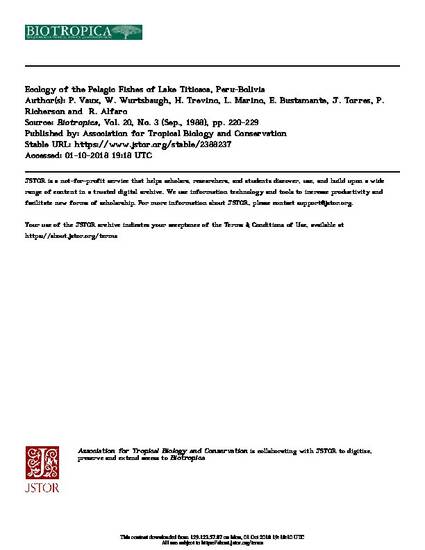
Article
Ecology of the Pelagic Fishes of Lake Titicaca, Peru-Bolivia
Biotropica
(1988)
Abstract
Gill nets set at three depths at an open-water station in Lake Titicaca during August 1984 captured only two species of endemic killifishes (Orestias ispi and 0. mulleri) and an exotic silverside (Basilichthyes bonariensis). These species segregated strongly by depth, with B. bonariensis and 0. mulleri occurring only in the surface and bottom sets, respectively, and 0. ispi being most abundant in the mid-water set. All three species were feeding on zooplankton, but 0. mulleri also included benthic crustaceans in its diet. Copepods were strongly selected by large (>200 mm SL) B. bonariensis, whereas smaller size classes ate mainly cladocerans. Copepods and cladocerans were about equally represented in the average diet of adult 0. ispi, but larvae contained only copepods. Analysis of egg size-frequency distributions of gill-netted and seine-netted samples suggested that both Orestias species are fractional spawners. Horizontal trawls, made at depths between 10 m and the bottom, collected mainly Orestias larvae. Echo-sounding traces suggested that the depth distribution of the Titicaca pelagic fish fauna changed little on a diel basis.
Disciplines
Publication Date
1988
Citation Information
Wayne A. Wurtsbaugh. "Ecology of the Pelagic Fishes of Lake Titicaca, Peru-Bolivia" Biotropica Vol. 20 Iss. 3 (1988) p. 220 - 229 Available at: http://works.bepress.com/wayne_wurtsbaugh/286/
